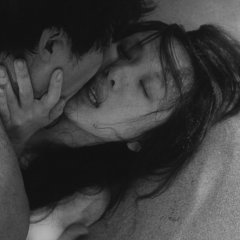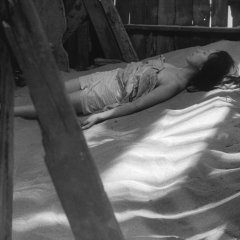 Cat-Loving Haruki Murakami and the Abundance of Movie Adaptations
Cat-Loving Haruki Murakami and the Abundance of Movie Adaptations - Português (Portugal)
- Português (Brasil)
- English
- magyar / magyar nyelv
- Título original: 砂の女
- Também conhecido como: Suna no onna , Sand Woman
- Diretor: Teshigahara Hiroshi
- Gêneros: Thriller, Vida, Drama, Adulto
Elenco e Créditos
- Okada Eiji Papel Principal
- Kishida Kyoko[Woman]Papel Principal
- Yano Sen[Villager]Papel Secundário
- Mitsui Koji Desconhecido
- Kanze Hideo Desconhecido
- Sekiguchi Ginzo Desconhecido
Resenhas

“Are you shoveling to survive, or surviving to shovel?”
This lone stretch of dialogue succinctly sums up the thematic heart of Woman in the Dunes. It is a momentous parable that speaks of the human condition—but which part and to what effect? Is this a story of emancipation despite physical confinement? Perhaps our characters are two Sisyphuses, doomed sinners and prisoners twice over. Or maybe things are more hopeful, despite the bleak atmosphere of the story. What if all of us are digging away at the sands of life, just trying to stay ahead day by day, lest we be crushed? We might be stuck struggling at the bottom forever, but at least there –is- still a bottom. And we may not be alone down there forever, either. What do you think it might be?
Woman in the Dunes speaks to the viewer on a visceral level, using shots so finely detailed as to tickle the senses. There are times the sand moves vibrantly across the screen—one might expect to dip their fingers through the television and feel the grains. Once when the male lead drinks from the limited water, I cringed, almost tasting the salty corruption of the sands.
Our leads engage in an intense sexual relationship, one desperate yet almost like a calculated carnal exchange. The woman acts as a seductress—to bind the man to her?—yet something about the scenes build up and inflame to suggest more as the film rolls along. Please be prepared for sexual elements as they play a large role in Woman in the Dunes. It is not quite a “pink film,” however; we predate those by several years.
Despite the exemplary cinematography, my favorite element of this film must be the score. Without the stylings of Takemitsu Toru, the uncanny atmosphere of Woman in the Dunes would be shattered. He lends scenes an off-kilter feel, sometimes even palpable suspense, though they might seem otherwise quiet. This helps build the overall effect of the film to its crescendo. One effect in particular left an impression on me: a high-pitched sound, as if rocks were scraping across a tin roof.
Esta resenha foi útil para você?

A magnificent piece of filmmaking, the picture uses visual metaphors and allegory as a form of social commentary. What exactly is its message? You decide, but there's absolutely no doubt that every piece of cinematic tool is put to the most effective use in an effort to help you decipher what you will.
The roles are well cast, the performances alternately heartfelt and disturbing, the story layered with symbolism and pregnant with meaning. The cinematography dazzling in its simplicity. Even more, what particularly struck me was how nature and sound became characters in their own right, enriching the film's atmosphere with a foreboding presence.
I loved the movie because it inspires me as someone who wants to make films and it provides me with entertainment that seduces my brain and leaves a catch in my breath.
This is certainly worth your time if you like your films artful and intelligent, but coincidentally it can also be consumed as mindless entertainment. If you so choose. You can choose to not look for its deeper meaning and just be caught up in the urgent passions of the film's protagonists.
Woman in the Dunes is outstanding, and gets an overall 10 from me for a story filled with impeccable nuance, skillful direction of actors, camera, space and time; and last but least how elementary tools of the craft were used to create something visually appealing and all together intellectually compelling.
Where I'm concerned this goes to show that old school filmmakers remain the true masters of cinema.
Esta resenha foi útil para você?





















































